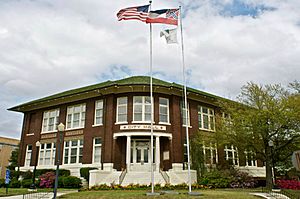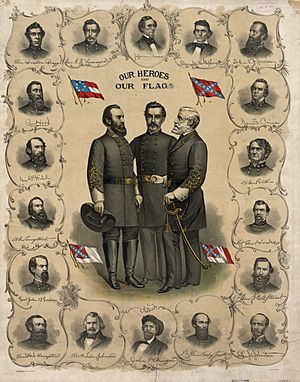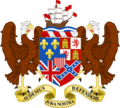Modern display of the Confederate battle flag facts for kids
The Confederate States of America was a group of Southern states that separated from the United States between 1861 and 1865. This happened just before and during the American Civil War. Even though the Confederacy ended, its main battle flag is still shown today. People started displaying it more often in 1948. This was when a political group called the Dixiecrats used it. They were against equal rights for African Americans and supported racial segregation, which meant keeping people of different races separate. The flag was also used more during the Civil Rights Movement in the 1950s and 1960s. This was a time when many people fought for equal rights for all.
Showing flags linked to the Confederacy is very controversial. Some people who support the flag say it represents pride in Southern heritage. They also say it stands for states' rights and remembering the Civil War. However, others believe the flag celebrates the Civil War and a false idea called the "Myth of the Lost Cause". They see it as a symbol of racism, slavery, segregation, and white supremacy. It can also be seen as a way to scare African Americans. Because of events like the Unite the Right rally and the murder of George Floyd, many places have banned the flag. Its official display has mostly stopped.
Understanding the Confederate Flags
Different National Flags
The Confederate States of America used three different national flags during the Civil War. These flags were used from 1861 to 1865. They were called the "Stars and Bars" (1861–1863), the "Stainless Banner" (1863–65), and the "Blood-Stained Banner" (1865).
The "Stars and Bars" was not very popular. It looked too much like the flag of the United States. This caused confusion during battles. Because of this, a new battle flag design became popular. This design was then added to the "Stainless Banner" and "Blood-Stained Banner". However, these new national flags also did not become widely used. The "Stainless Banner" had too much white. People worried it could be mistaken for a flag of surrender. It also got dirty easily. The "Blood-Stained Banner" was made just a month before the Confederacy gave up. So, very few of these flags were ever made or used.
The "Confederate Flag" We See Today
The flag most people call "the Confederate flag" today was first designed by William Porcher Miles. He was in charge of the Flag and Seal Committee for the Confederacy. This design was first suggested as a national flag in 1861, but it was not chosen.
However, the Army of Northern Virginia (ANV) used this design as a battle flag. This army was led by General Robert E. Lee. The flag became very popular throughout the Confederacy. To save fabric, the ANV made Miles's rectangular design into a square for their battle flag.
The rectangular version, similar to a flag used by the Army of Tennessee, is the most common one seen today. Even though this flag was never the official national flag of the Confederacy, it is widely known as "the Confederate Flag." It has become a strong symbol of the American South. It is also called the "rebel flag," "Dixie flag," "Confederate battle flag," or "Southern cross." People who are against the flag sometimes call it the "Dixie swastika." Many people mistakenly think this flag was the Confederacy's national flag. They often incorrectly call it the "Stars and Bars."
Official Use in Southern U.S. States
After the Civil War, many former slave states that were part of the Confederacy changed their state flags. They often used designs from the Confederate flags, like the "St. Andrew's cross." In states like Mississippi, Florida, and Alabama, these new flags appeared around the same time as new Jim Crow laws. These laws enforced racial segregation. They also made it harder for African Americans to vote for many years.
Historian John M. Coski noted that these flag changes happened when strict segregation laws were being passed. He said that Mississippi added a Confederate battle flag to its state flag four years after it passed laws to stop most African Americans from voting.
State Flags
Alabama's Flag
The current Flag of Alabama was adopted on February 16, 1895. It is a red cross of St. Andrew on a white background. The cross lines must be at least six inches wide and go diagonally across the flag.
An article from 1917 suggested that the purpose of this flag law was to keep some parts of the Confederate Battle Flag design.
Arkansas's Flag
The flag of Arkansas has four blue stars inside a diamond shape. These stars stand for the four countries that once controlled the area. One of these stars represents the Confederate States of America. The border around the white diamond looks like the cross on the Confederate battle flag. In 2019, a bill to change the star to represent Native Americans was not approved.
Florida's Flag
Florida's current flag was chosen in 1900. It has a red Cross of Burgundy. Many believe this cross was added to remember and support the Confederacy. Governor Francis P. Fleming, a former Confederate soldier, suggested adding the cross. He strongly supported racial segregation. However, some historians think the flag design comes from a Spanish flag used in Florida in the 1500s.
Georgia's Flag
In 1956, the Georgia state flag was changed to include the Confederate battle flag. In the 1990s, groups like the NAACP protested this design. They wanted the battle flag removed. In 2001, Georgia Governor Roy Barnes introduced a new design. It still showed the battle flag, but it was much smaller.
The next year, the Georgia General Assembly changed the flag again. They used the 13-star First National Flag of the Confederacy (the "Stars and Bars"). They combined it with a simpler version of Georgia's state seal. This seal was placed inside the circle of 13 stars.
The city flag of Trenton, Georgia, was adopted in 2001. This was a protest against the change of the state flag. The Trenton flag includes the Confederate Battle Flag and has been controversial.
Mississippi's Flag

The Confederate battle flag became part of the flag of Mississippi in 1894. In 1906, the laws about the flag were accidentally left out of the state's new legal rules. This meant Mississippi did not have an official flag. This mistake was not found until 1993. In 2000, Governor Ronnie Musgrove made the flag official again.
After more debate, the people of Mississippi voted on April 17, 2001. They voted 2 to 1 to keep the Confederate Battle Flag on their state flag.
During the George Floyd protests in 2020, there was more talk about changing the flag. On June 27, 2020, the Mississippi Legislature voted to discuss and vote on a bill to remove the flag. On June 28, both parts of the legislature passed a bill to get rid of the state flag. It also said the flag must be removed from public places within 15 days. A group would design a new flag that would not have the Confederate battle flag. It would include the words "In God We Trust". Governor Tate Reeves signed this bill into law on June 30, 2020.
North Carolina's Flag
North Carolina's first flag, adopted in 1861, had two ribbons. One ribbon said "May 20th, 1775." The other said "May 20, 1861," which was the date North Carolina left the Union.
The new flag, adopted in 1885, changed the design and colors. The date of North Carolina's secession was replaced with "April 12, 1776."
Tennessee's Flag
The current Flag of Tennessee was designed by Colonel Lee Roy Reeves. It was officially adopted in 1905. While its meaning is said to be only about Tennessee, its colors and design look like Confederate flags. The red background and blue shape with white outlines look like the Confederate Battle Flag. The vertical bar on the side looks like the Confederacy's Third National Flag. The designer's words about the three central stars also sound like the cross on the Confederate Battle Flag.
Some experts believe the Tennessee flag has a hidden link to the Confederacy. They say that many people in Tennessee have seen and still see this connection.
State Symbol: Stone Mountain
Stone Mountain, Georgia, is a huge "monument to the Confederacy." The state of Georgia paid for and owns it. Stone Mountain Park opened exactly 100 years after Abraham Lincoln was killed. It is the most visited place in Georgia.
Four flags of the Confederacy are flown at Stone Mountain. Also, the Stone Mountain Memorial Lawn has "thirteen terraces." Each terrace is for one Confederate state. Each terrace flies the flag that state used when it was part of the Confederacy.
State Seals
The first Confederate flag appears on the Seal of Texas. It is shown with flags from five other nations that once ruled Texas. These include Spain, France, Mexico, the Republic of Texas, and the United States. They are shown above an entrance to the Capitol building. They also appear on the back of the state seal.
The Alabamian coat of arms also features the Confederate battle flag's cross design. Like Texas, this cross on the coat of arms represents one of the five countries that ruled parts of Alabama.
The shield of the Confederacy was once in the Florida Capitol. It was shown with shields from France, Spain, Great Britain, and the United States. All were treated as equal "nations" that governed Florida. The five flags that "have flown in Florida" were also on the official Senate seal. On October 19, 2015, the Senate agreed to change the seal. They removed the Confederate battle flag. The new Senate seal (from 2016) only has the flags of the United States and Florida.
Vehicle License Plates
In several Southern states, car owners can get a special license plate. These plates feature the Sons of Confederate Veterans logo. This logo includes the square Confederate battle flag. These states are Alabama, Georgia, Louisiana, Mississippi, North Carolina, South Carolina, and Tennessee.
In 2015, a disagreement about Texas license plates with the logo went to the Supreme Court of the United States. The court decided that license plates are a form of government speech. This means the government can choose what is printed on them. So, Texas's choice not to issue flag-emblazoned plates did not violate free speech.
Also in 2015, Virginia recalled its license plates that had the Confederate flag emblem. They sent new plates to people who had the old ones. The old design was no longer valid.
Display at the South Carolina State Capitol

The Confederate battle flag was raised over the South Carolina State House on April 11, 1961. This was supposedly part of celebrations for the 100th anniversary of the Civil War. However, many historians believe it was meant to show Southern resistance to the growing Civil Rights Movement. In March 1962, lawmakers passed a rule to keep the flag flying over the State House.
In 1996, then-governor David Beasley wanted to remove the flag. But he later changed his mind and was voted out of office.
On April 12, 2000, the South Carolina Senate voted to remove the Confederate flag from the top of the State House dome. A new bill said a more traditional battle flag would fly in front of the Capitol. It would be next to a monument honoring Confederate soldiers. This bill also passed the South Carolina House of Representatives.
On July 1, 2000, the flag was removed from the State House roof. Civil War re-enactors then raised a Confederate battle flag on a 30-foot pole. This pole was on the front lawn of the Capitol. State law said the flag could not be removed from the grounds without another law.
In 2005, a study found that 74% of African Americans wanted the flag removed completely. The NAACP and other civil rights groups protested the flag's presence. The NAACP boycotted South Carolina for 15 years. They stopped the boycott only after the flag was finally removed from the State House grounds.
In 2000, the NCAA said it would cancel future events in South Carolina. This was if the state did not remove the Confederate battle flag from its capitol. They said the flag created an unwelcoming environment for many athletes. This ban stopped South Carolina from hosting many championship sporting events.
In June 2015, Bree Newsome, an activist, climbed the flagpole and removed the flag. On July 10, 2015, Republican governor Nikki Haley ordered the flag removed. It was then given to a museum.
July 10: A Day of Debate in Columbia
Groups have been arguing about whether to celebrate the flag's removal on July 10. After 2015, the South Carolina Secessionist Party sometimes raised the flag on a temporary pole at the capitol on July 10. This was allowed because they got permission for an event. The flag was always watched and removed at the end of the event.
- In 2019, the Secessionist Party's permit was only for a few hours in the morning. Another group had reserved the rest of the day to prevent the flag from being put up.
- In 2020, different groups applied at the same time. The State House Memorial Honor Guard flew the flag for a few hours.
Remington, Virginia
From 1985 to late 2020, the town of Remington, Virginia, had a Confederate flag in its official seal. A version of the seal, with the flag, was on their police uniforms.
The Remington town council voted to remove the Confederate flag from its seal on July 20, 2020. Remington was likely the last town to remove the Confederate flag from its official symbol.
Official Use in Americana, Brazil
From 1975 to 1998, a version of the Confederate battle flag was on the coat of arms and flag of Americana, São Paulo, Brazil. This city was settled by people who left the Confederacy after the Civil War.
Presence in Other Parts of the World
American culture is shared around the world. Because of this, the Confederate flag is seen in other countries too. Different groups use it, but not always consistently. Like in the United States, the flag is displayed for various reasons. However, it is most often linked to slavery and racism. In Germany and Poland, where Nazi symbols are banned, far-right groups sometimes use the Confederate flag instead. In Italy, some Southern soccer fans show the flag. They use it to show their unhappiness with Northern Italy.
Some people outside the U.S. display the flag as a fun symbol of "rebellion." They do not attach any deep political meaning to it. For example, fans of sports teams in Cork, Ireland, have waved the flag. This is because County Cork is called "the Rebel County." In 2017, the Cork GAA president asked fans not to use such flags. His successor in 2020 said they would be taken away at stadiums.
In Northern Ireland, Confederate symbols are sometimes used by groups called Ulster Loyalists. These groups are often far-right. They sometimes accept the flag's link to racism. They also point to a shared background between some Confederate leaders and Northern Irish Protestants. Some loyalist groups have displayed Confederate symbols.
The car-focused subculture called raggare in Sweden sometimes uses the flags on their cars and clothes. They see it as a cool symbol of America, without political meaning. They use it along with other American symbols like cowboy hats and old American cars.
In most of these cases, the Confederate flag is not a long-standing or common symbol for these groups. For example, Southern Italian and Cork sports fans use local symbols much more often. For far-right groups outside the U.S., the Confederate flag is just one of many flags they display. They often show it with flags from other historical groups linked to white supremacy.
Removals After George Floyd Protests
After major sports organizations threatened to ban games in Mississippi, the Mississippi Legislature passed a bill in June 2020. This bill got rid of the state flag. It also said the flag must be removed from public places within 15 days. A group would design a new flag that would not have the battle flag. It would include the words "In God We Trust". Governor Tate Reeves signed this bill into law on June 30, 2020.
The flag commission asked for new flag designs from the public. The winning design was put to a vote on November 3, 2020. Mississippi voters strongly approved the new flag. The new flag became official on January 11, 2021.
Images for kids
-
City Hall in Laurel, Mississippi in 2012
-
The flag flying at the South Carolina Confederate Monument in Columbia, South Carolina

















